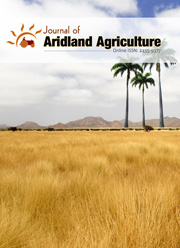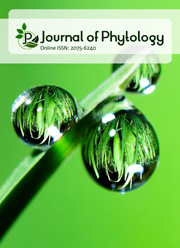Estimating the infection severity and infection percentage by aphids on eggplant varieties
DOI:
https://doi.org/10.25081/jaa.2023.v9.7676Keywords:
Eggplant, Aphis gossypii, Arthropod-plant interaction, ResistanceAbstract
Finding a new source of resistance is important to reduce the use of synthetic pesticides, which can meet the global need of suppressing pollution. In this study, the resistance of eight eggplant cultivars to Aphis gossypii was evaluated. Results of the current study highlighted that the cultivar Long-Green has a very strong resistance after 14 days post infestation whereas Pearl-Round and White-Casper cultivars were susceptible. The rest of the tested cultivars (Green-oblong, Purple-panter, Paris, Ashbilia, and Barcelona) had mild resistance. Also, the study found significant differences between the infested and non-infested plants among the tested cultivars in the plant’s height, fresh-, and dry-weight. The susceptible cultivars lost about 30% of their height, fresh- and dry-weight after the infestation compared with the cultivars that had mild resistance. Pearl-Round and White-Casper showed a very strong susceptibility among the evaluated cultivars which may be used as an element in the pest control program against A. gossypii.
Downloads
References
Abdul-Rassoul, M. S., Al-Jalely, B. H., Al-Nuaim, K. T., & Al-Ani, L. (2012). First record of red-back spider Latrodectus scelio Thorell, 1870 (Araneae: Theridiidae) in Baghdad, Iraq. Bulletin of the Iraq Natural History Museum, 12(2), 1-5.
Adhab, M. (2010). Identification of the causal agent of strip shape leaves symptoms on tomato in protective houses. Iraqi Journal of Biotechnology, 9(3), 607-617.
Adhab, M. (2021). Be smart to survive: Virus-host relationships in nature. Journal of Microbiology, Biotechnology and Food Sciences, 10(6), e3422. https://doi.org/10.15414/jmbfs.3422
Adhab, M. A., & Schoelz, J. E. (2015). Report of the turnip aphid, Lipaphis erysimi (Kaltenbach, 1843) from Missouri, USA. Journal of Plant Protection Research, 55(3), 327-328. https://doi.org/10.1515/jppr-2015-0035
Adhab, M., Finke, D., & Schoelz, J. (2019). Turnip aphids (Lipaphis erysimi) discriminate host plants based on the strain of Cauliflower mosaic virus infection. Emirates Journal of Food and Agriculture, 31(1), 69-75.
Aguirre-Rojas, L. M., Khalaf, L. K., & Smith, C. M. (2019). Barley varieties stoneham and sydney exhibit mild antibiosis and antixenosis resistance to the wheat curl mite, Aceria tosichella (Keifer). Agronomy, 9(11), 748. https://doi.org/10.3390/agronomy9110748
Aguirre-Rojas, L. M., Khalaf, L. K., Garcés-Carrera, S., Sinha, D. K., Chuang, W.-P., & Smith, C. M. (2017). Resistance to wheat curl mite in arthropod-resistant rye-wheat translocation lines. Agronomy, 7(4), 74. https://doi.org/10.3390/agronomy7040074
Al-Aani, F. S., Darr, M. J., Covington, B. R., & Powell, L. J. (2016). The performance of farm tractors as reported by can-bus messages. 2016 ASABE Annual International Meeting (p. 1). American Society of Agricultural and Biological Engineers. https://doi.org/10.13031/aim.20162461746
Al-Aani, F. S., Darr, M. J., Powell, L. J., & Covington, B. R. (2018). Design and validation of an electronic data logging systems (CAN Bus) for monitoring machinery performance and management-Planting application. 2018 ASABE Annual International Meeting (p. 1). American Society of Agricultural and Biological Engineers. https://doi.org/10.13031/aim.201800964
Al-Ani, L. K. K. (2010). Susceptibility of water melon cultivars to infestation by the two spotted spider mites. Iraqi Journal of Agricultural Sciences, 41(4), 86-91.
Al-Ani, R. A., Adhab, M. A., & Hamad, S. A. (2011c). Evaluation the efficiency of different techniques for extraction and purification of Tomato yellow leaf curl virus (TYLCV). Baghdad Science Journal, 8, 447-452.
Al-Ani, R. A., Adhab, M. A., & Ismail, K. A. H. (2011a). Eggplant blister mottled virus (EBMV): A possible new potyvirus characterized from Iraq. Journal of General and Molecular Virology, 3(3), 49-54.
Al-Ani, R. A., Adhab, M. A., El-Muadhidi, M. A., & Al-Fahad, M. A. (2011b). Induced systemic resistance and promotion of wheat and barley plants growth by biotic and non-biotic agents against barley yellow dwarf virus. African Journal of Biotechnology, 10(56), 12078-12084.
Al-Ani, R. A., Sabir, L. J., Adhab, M. A., & Hassan, A. K. (2009). Response of some melon cultivars to infection by Cucumber mosaic virus under field conditions. Iraqi Journal of Agricultural Science, 40(6), 1-8.
Al-Neami, K. T., Al-Dorri, O. K., & Kahtan, L. K. (2011). Effect of water extracts of some plants on two-spotted spider mites Tetranychus urticae Koch (Acariformes: Tetranychidae). Iraqi Journal of Agricultural Science, 42(1), 111-117.
AlShabar, S. H., Timm, A., & Khalaf, L. (2021). Population variation of Polyphagotarsonemus latus (Banks) in Baghdad province, central Iraq. 2021 Third International Sustainability and Resilience Conference: Climate Change (pp. 138-141). IEEE. https://doi.org/10.1109/IEEECONF53624.2021.9668098
Avelar, S., Schrimsher, D. W., Lawrence, K., & Brown. J. K. (2019). First report of Cotton leafroll dwarf virus associated with cotton blue disease symptoms in Alabama. Plant Disease, 103(3), 1-2. https://doi.org/10.1094/PDIS-09-18-1550-PDN
Baazeem, A., Alotaibi, S. S., Khalaf, L. K., Kumar, U., Zaynab, M., Alharthi, S., Darwish, H., Alghamdi, A., Jat, S. K., Al-Barty, A., Albogami, B., Noureldeen, A., & Ravindran, B. (2022). Identification and environment-friendly biocontrol potential of five different bacteria against Aphis punicae and Aphis illinoisensis (Hemiptera: Aphididae). Frontiers in Microbiology, 13, 961349. https://doi.org/10.3389/fmicb.2022.961349
Blackman, R. L., & Eastop, V. F. (2000). Aphids on the world’s crops: an identification and information guide. Chichester, UK: Wiley & Sons.
Chuang, W.-P., Rojas, L. M. A., Khalaf, L. K., Zhang, G., Fritz, A. K., Whitfield, A. E., & Smith, C. M. (2017). Wheat Genotypes with combined resistance to wheat curl mite, wheat streak mosaic virus, wheat mosaic virus, and triticum mosaic virus. Journal of Economic Entomology, 110(2), 711-718. https://doi.org/10.1093/jee/tow255
Dixon, A. F. G. (1997). Aphid ecology: an optimization approach. (2nd Ed.). Dordrecht, Netherlands: Springer.
Docimo, T., Francese, G., Ruggiero, A., Batelli, G., De Palma, M., Bassolino, L., Toppino, L., Rotino, G. L., Mennella, G., & Tucci, M. (2016). Phenylpropanoids accumulation in eggplant fruit: Characterization of biosynthetic genes and regulation by a MYB transcription factor. Frontiers in Plant Science, 6, 1233. https://doi.org/10.3389/fpls.2015.01233
FAOSTAT. (2021). Food and Agriculture Organization of the United Nations. Retrieved from https://www.fao.org/faostat/en/#data/QCL
Fontes, E. M. G., Ramalho, F. de S., Underwood, E., Barroso, P. A. V., Simon, M. F., Sujii, E. R., Pires, C. S. S., Beltrão, N. E., Lucena, W. A., & Freire, E. C. (2006). The cotton agriculture context in Brazil. In A. Hilbeck, D. A. Andow & E. M. G. Fontes (Eds.), Environmental risk assessment of genetically modified organisms: methodologies for assessing Bt cotton in Brazil. Wallingford, UK: CABI.
Ghosh, S. K. (2012). Sustainable Management of Aphid (Aphis gossypii Glover) Infesting Brinjal (eggplant), Solanum Melongena (Linn.). In S. Tyagi (Eds.), Hi-Tech Horticulture (Vol. 4, pp. 77-99) New Delhi, India: New India Publishing Agency.
Gürbüz, N., Uluişik, S., Frary, A., Frary, A., & Doğanlar, S. (2018). Health benefits and bioactive compounds of eggplant. Food Chemistry, 268, 602-610. https://doi.org/10.1016/j.foodchem.2018.06.093
Kern, M., Meiners, T., Schliephake, E., Habekuss, A., Ordon, F., & Will, T. (2022). Infection of susceptible/tolerant barley genotypes with Barley yellow dwarf virus alters the host plant preference of Rhopalosiphum padi clones depending upon their ability to transmit BYDV. Journal of Pest Science, 95, 215-229. https://doi.org/10.1007/s10340-021-01367-2
Khalaf, L. K., Adhab, M., Aguirre-Rojas, L. M., & Timm, A. E. (2023). Occurrences of wheat curl mite Aceria tosichella Keifer 1969 (Eriophyidae) and the associated viruses, (WSMV, HPWMoV, TriMV) in Iraq. Iraqi Journal of Agricultural Sciences, 54(3), 837-849. https://doi.org/10.36103/ijas.v54i3.1767
Khalaf, L., Chuang, W.-P., Aguirre-Rojas, L. M., Klein, P., & Smith, C. M. (2019). Differences in Aceria tosichella population responses to wheat resistance genes and wheat virus transmission. Arthropod-Plant Interactions, 13, 807-818. https://doi.org/10.1007/s11829-019-09717-9
Khalaf, L., Timm, A., Chuang, W.-P., Enders, L., Hefley, T. J., & Smith, C. M. (2020). Modeling Aceria tosichella biotype distribution over geographic space and time. PloS One, 15(5), e0233507. https://doi.org/10.1371/journal.pone.0233507
Kocourek, F., Havelka, J., Beránková, J., & Jaroŝik, V. (1994). Effect of temperature on development rate and intrinsic rate of increase of Aphis gossypii reared on greenhouse cucumbers. Entomologia Experimentalis et Applicata, 71(1), 59-64.
Liang, P.-Z., Ma, K.-S., Chen, X.-W., Tang, C.-Y., Xia, J., Chi, H., & Gao, X.-W. (2019). Toxicity and sublethal effects of flupyradifurone, a novel butenolide insecticide, on the development and fecundity of Aphis gossypii (Hemiptera: Aphididae). Journal of Economic Entomology, 112(2), 852-858. https://doi.org/10.1093/jee/toy381
Mauro, R. P., Agnello, M., Rizzo, V., Graziani, G., Fogliano, V., Leonardi, C., & Giuffrida, F. (2020). Recovery of eggplant field waste as a source of phytochemicals. Scientia Horticulturae, 261, 109023. https://doi.org/10.1016/j.scienta.2019.109023
Michelotto, M. D., & Busoli, A. C. (2007). Caracterização da transmissão do vírus do mosaicodas-nervuras do algodoeiro pelo pulgão Aphis gossyphii com relação à persistência e ao tempo necessário para inoculação. Bragantia, 66(3), 441-447. https://doi.org/10.1590/S0006-87052007000300010
Mukherjee, A. K., Mukherjee, P. K., & Kranthi, S. (2016). Genetic similarity between cotton leafroll dwarf virus and chickpea stunt disease associated virus in India. Plant Pathology Journal, 32(6), 580-583. https://doi.org/10.5423/PPJ.NT.09.2015.0197
Nauen, R., & Elbert, A. (2003). European monitoring of resistance to insecticides in Myzus persicae and Aphis gossypii (Hemiptera: Aphididae) with special reference to imidacloprid. Bulletin of Entomological Research, 93(1), 47-54. https://doi.org/10.1079/BER2002215
SAS. (2009). The SAS system for Windows. Release version 9.2. Cary, NC: SAS institute.
Shrestha, R. B., & Parajulee, M. N. (2013). Potential cotton aphid, Aphis gossypii, population suppression by arthropod predators in upland cotton. Insect Science, 20(6), 778-788. https://doi.org/10.1111/j.1744-7917.2012.01583.x
Slosser, J. E., Parajulee, M. N., Hendrix, D. L., Henneberry, T. J., & Rummel, D. R. (2002). Relationship between Aphis gossypii (Homoptera: Aphididae) and sticky lint in cotton. Journal of Economic Entomology, 95, 299-306. https://doi.org/10.1603/0022-0493-95.2.299
Smith, C. M. (1999). Plant resistance to insects. In J. Rechcigl & N. Rechcigl (Eds.), Biological and Biotechnological Control of Insect Pests (pp. 171-208) Florida, US: CRC Press.
Smith, C. M. (2005). Plant Resistance to Arthropods - Molecular and Conventional Approaches. Dordrecht, Netherlands: Springer.
Zhao, J., Abdelsalam, N. R., Khalaf, L., Chuang, W.-P., Zhao, L., Smith, C. M., Carver, B., & Bai, G. (2019). Development of single nucleotide polymorphism markers for the wheat curl mite resistance gene Cmc4. Crop Science, 59(4), 1567-1575. https://doi.org/10.2135/cropsci2018.11.0695
Published
How to Cite
Issue
Section
Copyright (c) 2023 Ahmed Bakir Aljuboory

This work is licensed under a Creative Commons Attribution-NonCommercial 3.0 Unported License.





 .
.